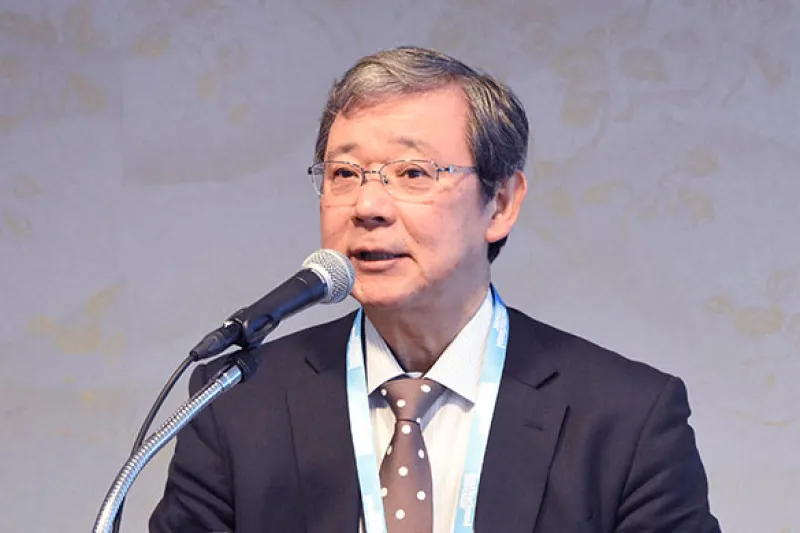Hideo Kondo is the Director of the DIC Pension Fund, which is sponsored by DIC Corporation, a chemical company in Japan that is a global leader in manufacturing inks. The assets of the defined benefit plan overseen by Kondo totaled approximately JPY 107 billion at the end of October 2019. Here he shares insights gained while overseeing the fund through market ups and downs.
“Because corporate pension funds are expected to operate over a very long term, we have to work constantly to produce annual gains on our total assets, even when interest rates are as low as they are now. To my mind, securing an annual return is simply reaping the fruits of economic and corporate growth. Since there is no Japanese version of Google or Amazon, the hunt for growth has moved mostly overseas. That has been my guiding strategy since 2004, when I decided there should be no passive funds in our equity investment. That active orientation separates us from the typical Japanese corporate pension fund.”
“Currently, a portion of our equity portfolio is allocated to private equity [PE] funds focused on growth-stage ventures in IT, healthcare, and consumer sectors in North America and the Asia Pacific region, and we have invested in infrastructure funds since 2004. Starting with a greenfield fund, our investments in infrastructure have since diversified into brownfield and renewable energy funds. Our PE and infrastructure investments include many supposedly ESG-integrated funds, though I have not actively sought ESG as a criterion.”
“What I’ve learned in 20 years of pension asset management is that a quick and decisive response to a changing market is essential. The quicker you move, the better you can develop a feel for new markets, such as venture and infrastructure, and the more effectively you can diversify the portfolio in each group.”
Learn more about Japan’s funds market.
“We allocate 45% of our assets to equities and 55% to fixed income – with the caveat that alternative assets should represent no more than 35% of total portfolio value. We currently maintain assets in low-liquid equity at around 17%, and the remainder is allocated to various hedge funds. Our combination of active equity management and low-liquidity assets proved effective during the financial crisis of 2008.”
“We restructured our asset allocation policy following the IT bubble in the early 2000s. As bond rates have drifted lower, we have shifted assets from domestic bonds to currency-hedged foreign bonds. After the Bank of Japan adopted a negative yield policy, we broadened our investment targets to include senior debt securities and open-ended real estate funds. Before we restructured our allocation policy, our fixed income objectives were to secure yield and mitigate equity risk, but today we’re focused on income producing assets and absolute return strategies.”
“One major challenge we face is preparing for an anticipated cash shortfall in six years, due to the growing imbalance between premiums and benefits. We have two choices: either adopt a new contribution system under which contribution rates could be pegged to foreseeable risk rates, or lower our planned interest rate on the pension liability to 2.0%. The current planned interest rate on the pension liability is 3.0%. The expected return and risk are set at 3.5% and 7.85%, respectively.”
“Early in my career, I was a portfolio manager for the bank’s account to invest in foreign bonds and U.S. equities at the Long-Term Credit Bank of Japan (LTCB) or Chou-gin. The bank failed and was nationalized in 1998. Although the Japanese bubble and Chou-gin stories were well known, I not very familiar with what happened because I was working at the time in the NY branch.”
“My time at DIC Pension Fund began in 1999, and comfortably so against the backdrop of a good market, and I began to learn about the pension system and regulatory requirements. Things changed dramatically starting in 2000, however, with three consecutive years of negative returns after the IT bubble burst in the U.S. That made me recognize the reality of markets and our responsibility.”
“In addition to a depressed market, we have been forced to deal with a reduction in funds caused by our sponsor company’s decision to make changes to its pension offering. Formerly, DIC Pension Fund managed both its corporate pension and a portion of public pension funds on behalf of the government. In 2004, DIC Pension returned the substitution part of the pension system to the government and adopted a defined benefit (DB) plan fully sponsored by DIC. In 2014, a portion of that DB plan was converted into a defined contribution (DC) plan. These changes have made our managed funds smaller and more vulnerable to market volatility. However, we have enough reserve surplus in our funds, and our balance sheet as a whole has been sufficiently protected from negative performance so that we can meet our DB pension obligations – primarily lifetime annuities to retirees. DIC Corporation’s balance sheet is shielded from pension fund losses as well. We anticipate low or negative interest rates will continue for the foreseeable future; however, ALM [asset-liability management] simulation predicts the DIC Pension Fund can maintain a positive balance with a 1% annual return over the next 20 years, using the fund’s surplus.”
“Looking back, our core strategy has been: Avoid losing in the market by being resilient to downtrend pressure. I think that policy has helped us always prepare for the future, and with a bit of luck our funds have performed rather well among Japanese corporate pensions, including through the global financial crisis and the trend of lowering interest rates that followed. It has been my wish to retire with a good surplus in our funds, which we have now.”






